Rural Scotland: key facts 2018
Biennial compendium publication comparing and contrasting statistics on key policy topics such as People and Communities, Services and Lifestyle, Economy and Enterprise broken down by Remote Rural, Accessible Rural and the Rest of Scotland.
People and Communities
Demographics
Table 1: Population by geographic area, 2011, 2016 & 2017
| 2011 |
2016 |
2017 |
% change 2011-2017 |
% change 2016-2017 |
|
|---|---|---|---|---|---|
| Remote Rural |
315,945 |
315,497 |
316,157 |
0.1% |
0.2% |
| Accessible Rural |
573,407 |
598,082 |
603,678 |
5.3% |
0.9% |
| Rest of Scotland |
4,410,548 |
4,491,121 |
4,504,965 |
2.1% |
0.3% |
| Total |
5,299,900 |
5,404,700 |
5,424,800 |
2.4% |
0.4% |
Source: Mid-year population estimates based on data zones, National Records of Scotland (Using Scottish Government Urban Rural Classification 2016)
Table 1 shows the population figures from the census in 2011 as well as the two most recently available years. Just over 5.4 million people live in Scotland, with over 900,000 of them living in rural areas.
Table 1 shows that between 2011 and 2017, the population has increased in all areas of Scotland. The greatest increase in population has been in accessible rural areas, with a 5.3% increase between 2011 and 2017, compared to an increase of 2.1% in the rest of Scotland. The population of remote rural areas only increased by 0.1%, which is an increase of only 212 people between 2011 and 2017.
Looking at the population figures for 2016, the remote rural population had actually decreased compared to 2011. The increase in the remote rural population in 2017 compared to 2011 therefore occurred in the last year. The largest increase in percentage terms between 2016 and 2017 was again seen in accessible rural areas, an increase of 0.9% in the population.
The overall increase in population in all areas of Scotland between 2016 and 2017 was primarily due to the positive net migration rates (as shown in Table 2).
Figure 1: Percentage of population and land by geographic area, 2017
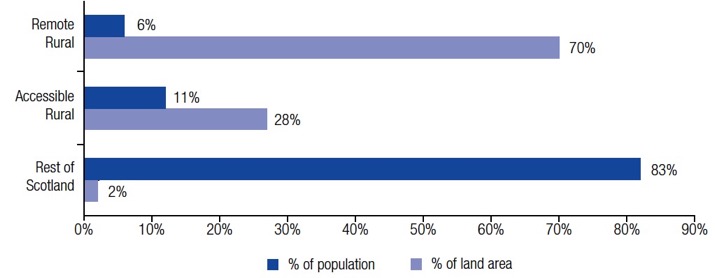
Source: Mid-year population estimates based on data zones, National Records of Scotland (Using Scottish Government Urban Rural Classification 2016)
The total land mass of Scotland is approximately 7.8 million hectares. Figure 1 shows that although rural Scotland accounts for 17% of the total population in Scotland (6% in remote rural and 11% in accessible rural), it accounts for 98% of the land mass in Scotland (70% in remote rural and 28% in accessible rural). This reflects the dispersed nature of the population in rural areas. In contrast, the rest of Scotland accounts for 83% of the population of Scotland but only 2% of the land mass.
Figure 2: Age distribution of population by geographic area, 2017
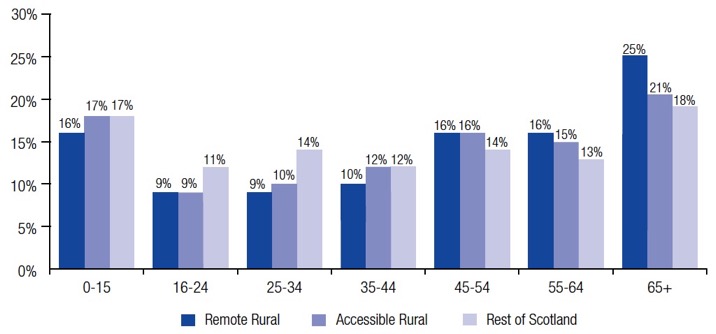
Source: Mid-year population estimates based on data zones, National Records of Scotland (Using the Scottish Government Urban Rural Classification 2016)
Figure 2 shows that the age distribution of rural areas compared to the rest of Scotland is markedly different for particular groups of the population. Specifically, rural areas have a lower proportion of the population in the age range 16 to 34 but a higher proportion of people aged 45 and over. This is particularly true for the age range of 65 and over in remote rural areas.
Evidence suggests that factors influencing migration decisions of young people moving out of rural areas could be higher education and employment opportunities, housing and public transport availability.
Table 2: Internal population change and migration by geographic area, 2017
Remote Rural |
Accessible Rural |
Rest of Scotland |
|
|---|---|---|---|
Births (2017) |
2,384 |
5,412 |
45,640 |
Births per 1,000 population |
8 |
9 |
10 |
Deaths (2017) |
3,517 |
5,578 |
48,151 |
Deaths per 1,000 population |
11 |
9 |
11 |
Migration (2016-17) |
|||
In-migration |
17,340 |
37,461 |
101,076 |
Out-migration |
15,653 |
31,709 |
84,661 |
Net migration |
1,687 |
5,752 |
16,415 |
Net migration as % of population |
0.5% |
1.0% |
0.4% |
Source: Migration Statistics, National Records of Scotland (Using Scottish Government Urban Rural Classification 2016)
Table 2 shows that the birth rate (per 1,000 population) was lower than the death rate in all areas of Scotland in 2017. The birth rate was closest to the death rate (per 1,000 population) in accessible rural areas.
The rate of births was higher in rest of Scotland (10 per 1,000 population) than in accessible rural (nine per 1,000 population) and remote rural (eight per 1,000 population) areas. The rate of deaths was highest in remote rural areas and the rest of Scotland (11 per 1,000 population for each area) than in accessible rural areas (nine per 1,000 population).
Table 2 also shows positive net migration into all three areas of Scotland over the year 2016 17, i.e. the number of in-migrants was greater than the number of out-migrants. The net migration rate was highest in accessible rural areas, equivalent to 1.0% of the population. The lowest net migration rate was in the rest of Scotland, equivalent to 0.4% of the population.
Table 3: Country of birth by geographic area, 2017
Remote Rural |
Accessible Rural |
Rest of Scotland |
|
|---|---|---|---|
Scotland |
75% |
79% |
81% |
Rest of UK |
21% |
17% |
9% |
Rest of World |
4% |
5% |
10% |
European Union |
2% |
3% |
5% |
non-European Union |
2% |
2% |
5% |
Total |
100% |
100% |
100% |
Source: Annual Population Survey, January to December 2017 (Using Scottish Government Urban Rural Classification 2016)
Table 3 shows the proportions of Scotland’s current population that were born in Scotland, in the rest of the United Kingdom and in the rest of the world, which is further split into European Union and non-European Union countries. Table 3 shows that the area with highest proportion of residents who were born in the UK but outside of Scotland is remote rural areas at 21%. The rate for accessible rural areas and the rest of Scotland were 17% and 9% respectively.
The area with the highest proportion of residents that were born outside the UK is the rest of Scotland (10%). In accessible rural areas 5% of residents were born outside of the UK and in remote rural areas it was 4%. In all areas of Scotland there is a roughly equal split of people who were born outside of the UK-born who were born in European Union countries and non-European Union countries.
Households
Table 4: Household type1 by geographic area, 2017
Remote Rural |
Accessible Rural |
Rest of Scotland |
|
|---|---|---|---|
Single adult |
15% |
15% |
21% |
Small adult |
19% |
19% |
19% |
Single parent |
4% |
4% |
5% |
Small family |
11% |
14% |
13% |
Large family |
5% |
6% |
5% |
Large adult |
9% |
11% |
10% |
Older smaller |
21% |
17% |
12% |
Single pensioner |
17% |
15% |
14% |
Total |
100% |
100% |
100% |
Source: Scottish Household Survey 2017 (Using Scottish Government Urban Rural Classification 2016)
Notes: 1. A description of all household types can be found under Definitions in the Notes section at the back of this booklet.
Table 4 shows that, relative to the rest of Scotland, remote and accessible rural Scotland have lower percentages of single adult households.
Accessible rural areas have the highest percentage of both ‘small family’ and ‘large family’ households compared to the rest of Scotland and remote rural areas. A ‘small family’ household contains two adults of any age and one or two children, while a ‘large family’ household contains two adults of any age and three or more children, or three adults of any age and one or more children.
Rural Scotland as a whole, and in particular remote rural areas, has a higher percentage of ‘older smaller’ households, where one or both adults are of pensionable age. In addition, remote rural areas have a higher proportion of single pensioner households compared to accessible rural areas and the rest of Scotland.
Neighbourhood and Community
Figure 3: Rating of neighbourhood as a place to live by geographic area, 2017
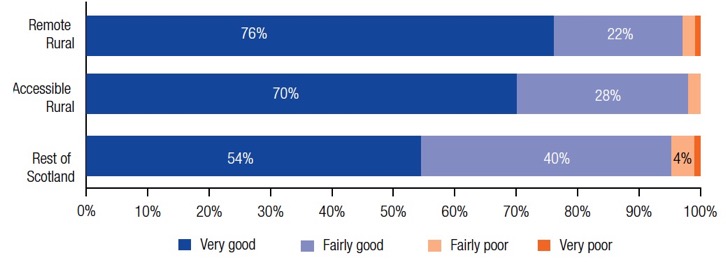
Source: Scottish Household Survey 2017 (Using Scottish Government Urban Rural Classification 2016)
Figure 3 shows that at least 94% of residents in all areas of Scotland rate their neighbourhood as a ‘very good’ or ‘fairly good’ place to live.
People living in remote rural areas are more likely to describe their neighbourhood as a ‘very good’ place to live (76%), compared to accessible rural areas (70%) and the rest of Scotland (54%).
Figures 4 and 5 and Tables 5 to 8 provide further detail on neighbourhoods and safety which may explain the results shown above.
In 2007, the Scottish Government introduced a National Indicator[1] to increase the percentage of adults who rate their neighbourhood as a good place to live.
Figure 4: Percentage of people who feel they belong to their immediate neighbourhood by geographic area, 2017
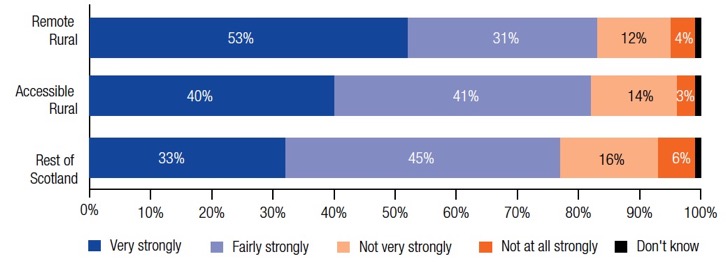
Source: Scottish Household Survey 2017 (Using Scottish Government Urban Rural Classification 2016)
A higher proportion of people who live in remote rural areas either feel ‘very strongly’ or ‘fairly strongly’ that they belong to their immediate neighbourhood than either people in accessible rural areas or the rest of Scotland. In remote rural areas, over half of people feel ‘very strongly’ that they belong to their immediate neighbourhood.
The proportion of people living in remote rural areas and accessible rural areas that either feel ‘not very strongly’ or ‘not at all strongly’ that they belong to their immediate neighbourhood are similar (16% and 17% respectively). In rest of Scotland the proportion of people that either feel ‘not very strongly’ or ‘not at all strongly’ that they belong to their immediate neighbourhood is higher (22%).
Table 5: Percentage of people who think they can influence decisions affecting their local area by geographic area, 2017
Remote Rural |
Accessible Rural |
Rest of Scotland |
|
|---|---|---|---|
Agree |
24% |
26% |
22% |
Neither agree or disagree |
18% |
17% |
19% |
Disagree |
50% |
51% |
51% |
No Opinion |
8% |
6% |
8% |
Total |
100% |
100% |
100% |
Source: Scottish Household Survey 2017 (Using Scottish Government Urban Rural Classification 2016)
Table 5 shows that he highest proportion of people who think they can influence decisions affecting their local area are in accessible rural areas (26%) followed by remote rural areas (24%). The proportion who think they can influence decisions affecting their local area is lowest in the rest of Scotland at 22%. This does not imply that people living in remote areas do actually have more influence over decisions that affect their local areas but they believe that they do.
In all areas of Scotland half of people do not think they can influence decisions that affect their local area. At between 6% and 8%, the proportion of people with no opinion regarding this question is relatively high as well.
Figure 5: Percentage of people who, if they were alone and needed help, could rely on one of their friends/relatives in their neighbourhood to help them by geographic area, 2017
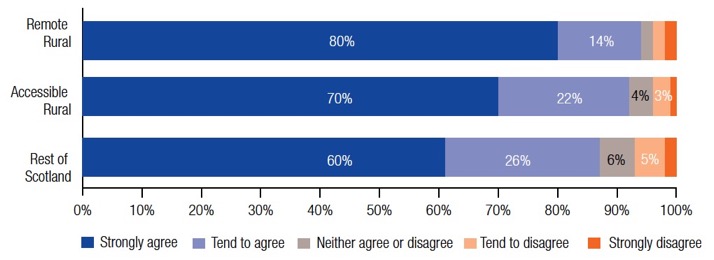
Source: Scottish Household Survey 2017 (Using Scottish Government Urban Rural Classification 2016)
In remote rural areas, 80% people ‘strongly agree’ that if they were alone and need help they could rely on one of her friends or relatives in their neighbourhood to help them. This compares to 70% of people in accessible rural areas and 60% in the rest of Scotland. This reinforces what is shown in Figure 4 that a higher proportion of people in rural Scotland feel they belong to their immediate neighbourhood.
When the ‘strongly agree’ and ‘tend to agree’ categories are combined the proportion of people who feel they rely on one of her friends or relatives in their neighbourhood to help them increase to 94% in remote rural areas, 92% in accessible rural areas and 86% in the rest of Scotland.
In the rest of Scotland, 7% of people ‘tend to disagree’ or ‘strongly disagree’ that if they were alone and need help they could rely on one of her friends or relatives in their neighbourhood to help them. This compares to 4% in both remote rural and accessible rural areas.
Table 6: Experience of neighbourhood problems1 by geographic area, 2017
Remote Rural |
Accessible Rural |
Rest of Scotland |
|
|---|---|---|---|
Vandalism, graffiti or other deliberate damage to property |
2% |
3% |
7% |
Groups or individuals intimidating or harassing others |
2% |
2% |
3% |
Seeing drug misuse or dealing |
3% |
3% |
8% |
Rowdy behaviour e.g. drunkeness, hooliganism or loutish behaviour |
4% |
5% |
12% |
Noisy neighbours or regular loud parties |
3% |
5% |
13% |
Neighbour disputes |
5% |
4% |
5% |
Rubbish or litter lying around |
20% |
21% |
31% |
Abandoned or burnt out vehicles |
3% |
2% |
2% |
Animal nuisance such as noise or dog fouling |
28% |
33% |
39% |
None |
56% |
52% |
41% |
Source: Scottish Household Survey 2017 (Using Scottish Government Urban Rural Classification 2016)
Notes: 1. Respondents can choose more than one option.
Table 6 shows that, across the range of categories, a lower percentage of people in remote and accessible rural areas have experienced neighbourhood problems. For example, only 3% in remote rural areas and 5% in accessible rural areas say they have had a problem with noisy neighbours or loud parties while the figure is 13% in the rest of Scotland. Similarly, 20% and 21% of people in remote and accessible rural areas respectively state that rubbish or litter lying around is a problem, whilst 31% state this is a problem in the rest of Scotland.
Animal nuisance, such as noise or dog fouling, is more of a problem in the rest of Scotland with 39% of people have experienced it. In accessible rural areas, 33% have experienced problems with animal nuisance and it is lowest in remote rural areas at 28%.
Over half of people in rural Scotland have experienced none of the neighbourhood problems listed. This compares to 41% in the rest of Scotland.
Table 7: Perceptions of safety when at home alone at night by geographic area, 2017
Remote Rural |
Accessible Rural |
Rest of Scotland |
|
|---|---|---|---|
Very safe |
91% |
89% |
80% |
Fairly safe |
8% |
10% |
17% |
A bit unsafe |
1% |
0% |
2% |
Very unsafe |
0% |
0% |
1% |
Don't know |
- |
0% |
0% |
Total |
100% |
100% |
100% |
Source: Scottish Household Survey 2017 (Using Scottish Government Urban Rural Classification 2016)
Table 7 shows that the vast majority of people in all areas of Scotland feel either ‘very safe’ or ‘fairly safe’ when at home alone at night. However, a higher proportion of people in remote rural areas (91%) and accessible rural areas (89%) state they feel ‘very safe’ compared to the rest of Scotland (80%).
Looking at people who felt ‘very unsafe’ when at home alone at night, there are 1% of people in the rest of Scotland who feel this way. This compares to less than 0.5% in both remote rural and accessible rural areas.
Table 8: Crime victimisation and perception of change in crimes rates over previous two years by geographic area, 2016-17
Remote Rural |
Accessible Rural |
Rest of Scotland |
|
|---|---|---|---|
Percentage of adults who had been the victims of crime in the last 12 months |
4% |
8% |
15% |
Proportion of adults who perceived that: |
|||
Crime rate has increased over last 2 years |
16% |
15% |
19% |
Crime rate has stayed the same over last 2 years |
75% |
75% |
63% |
Crime rate has decreased over last 2 years |
7% |
6% |
11% |
Don't know |
2% |
5% |
6% |
Total |
100% |
100% |
100% |
Source: Scottish Crime and Justice Survey 2016-17 (Using Scottish Government Urban Rural Classification 2013-2014)
The crime victimisation rates in Table 8 may provide an explanation as to why residents of rural Scotland are more likely to feel safe alone in their home at night (as shown in Table 7). A lower proportion of residents of remote rural (4%) and accessible rural (8%) areas had been victims of crime in the past 12 months than in the rest of Scotland (15%).
In terms of perception of changes in crime rates,
The majority of people across all areas of Scotland state they feel crime rates have remained the same over the last two years. Of those who feel there has been a change in the crime rate over the two previous years, more feel that crime rates have increased as opposed to decreased.
A lower proportion of people in rural Scotland state they feel crime has increased, when compared to the rest of Scotland. However, this is also true of the proportion of people who feel crime has decreased.
In 2007, the Scottish Government introduced National Indicators[2] to reduce overall crime victimisation rates and to increase positive public perception of the general crime rate in the local area.
Figure 6: Whether respondent gave their time to help as an organiser/volunteer in the past 12 months by age and geographic area, 2017
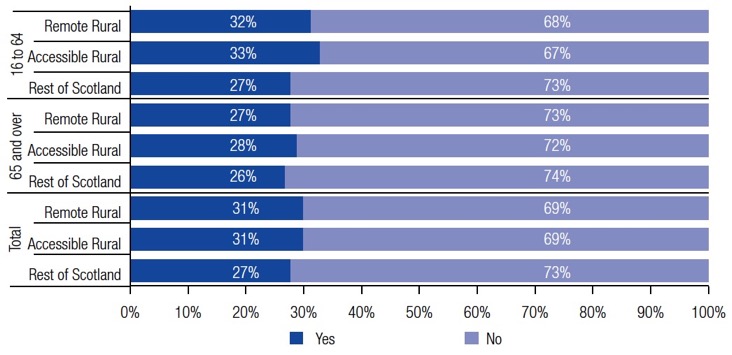
Source: Scottish Household Survey 2017 (Using Scottish Government Urban Rural Classification 2016)
In rural Scotland, a higher proportion of people give up their time to help as an organiser or a volunteer than in the rest of Scotland. This difference is more apparent for people aged 16 to 64, with 32% of this age group in remote rural areas and 33% in accessible rural areas giving up time to work as a volunteer/organiser, compared to 27% in the rest of Scotland.
The proportion of people who give up their time to help as an organiser or a volunteer, while still higher in rural areas, is broadly similar across Scotland for people aged 65 and over.
Overall a greater proportion of people aged 16 to 64 gave up time to work as an organiser/volunteer, compared to people aged 65 and over, in all areas of Scotland.
Physical Environment
Table 9: Walking distance to nearest greenspace1 by geographic area, 2017
Remote Rural |
Accessible Rural |
Rest of Scotland |
|
|---|---|---|---|
In 5 minutes |
76% |
74% |
63% |
6-10 minutes |
10% |
12% |
22% |
Within an 11-20 minute walk |
5% |
5% |
10% |
Within a 21-30 minute walk |
1% |
3% |
3% |
More than a 30 minute walk away |
7% |
6% |
2% |
Source: Scottish Household Survey 2017 (Using Scottish Government Urban Rural Classification 2016)
Notes: 1. A greenspace is a public green or open spaces in the local area, for example a park, countryside, wood, play area, canal path, riverside or beach.
Around three quarters of people living in rural Scotland live within five minutes walking distance of a greenspace. This falls to just under two thirds of people in the rest of Scotland. When looking at those people who are within ten minutes walking distance of a greenspace, the proportion across all areas of Scotland is very similar at around 86%.
However, remote rural areas have the highest proportion of people living more than 30 minutes walk from a greenspace (7%), while the rest of Scotland has the lowest proportion (2%).
Table 10: Satisfaction with local greenspaces1 by geographic area, 2017
Remote Rural |
Accessible Rural |
Rest of Scotland |
|
|---|---|---|---|
Very satisfied |
50% |
42% |
30% |
Fairly satisfied |
29% |
35% |
43% |
Neither satisfied nor dissatisfied |
7% |
9% |
11% |
Fairly dissatisfied |
5% |
5% |
7% |
Very dissatisfied |
3% |
2% |
4% |
No opinion |
7% |
8% |
6% |
Total |
100% |
100% |
100% |
Source: Scottish Household Survey 2017 (Using Scottish Government Urban Rural Classification 2016)
Notes: 1. A greenspace is a public green or open spaces in the local area, for example a park, countryside, wood, play area, canal path, riverside or beach.
In remote rural areas half of people are ‘very satisfied’ with their local greenspace. In total, 79% of people living in remote rural areas are either ‘very satisfied’ or ‘fairly satisfied’ with their local greenspace. This compares to 77% in accessible rural areas and 73% in the rest of Scotland.
In the rest of Scotland, 4% of people were ‘very dissatisfied’ with the local greenspace. This compares to 3% in remote rural areas and 2% in accessible rural areas.
Tables 9 and 10 show that not only are people in rural areas of Scotland likely to live closer to their nearest greenspace (within five minutes walk), but they are also more likely to be satisfied with the quality of their local greenspace compared to the rest of Scotland.
Contact
Neil Henderson: RuralStatistics@gov.scot
There is a problem
Thanks for your feedback